Nano Brewing Equipment TLC
Your brewery equipment is an investment and should be treated that way. While stainless steel can withstand a lot, it is not indestructible. Like all equipment, it will experience wear and tear and needs to be properly taken care of to make sure it is working as efficiently as possible and can last as long as you need it to.
Importance of Proper Care

Optimizing Efficiency
Efficient brewing operations rely on well-maintained equipment. When your equipment is in optimal working condition, it performs better and reduces the need for repairs and downtime. Poorly maintained equipment can result in slower production speeds, inconsistent product quality, and increased energy consumption. By keeping equipment clean and functioning properly, you ensure smooth, efficient operations that support both quality control and cost-effective brewing.
Enhancing Longevity
The lifespan of your brewery equipment can be significantly extended with proper care. Regular maintenance, such as cleaning, repassivation, and checking for leaks, ensures that the equipment can handle the wear it endures in daily use. When you address small issues early, they don’t evolve into larger problems that may require expensive repairs or replacements. Routine attention to your equipment’s needs prevents corrosion, rust, and damage from occurring, which can lead to premature failure. This proactive approach helps keep your equipment running for years, saving money in the long run.
Ensuring Consistent Beer Quality
Regular cleaning and sanitizing, as part of a broader care plan, are crucial for protecting the taste and safety of your product. Any residue, buildup, or contamination left unchecked can lead to off-flavors, fermentation issues, and poor beer quality. A well-maintained system helps to ensure that every batch is brewed under optimal conditions, supporting the consistency and integrity of your beer.
Maintaining Safety Standards
Proper equipment maintenance is also a key component in ensuring the safety of your brewery operations. Faulty equipment can lead to dangerous situations, such as pressure buildup, leaks, or electrical malfunctions, which pose risks to your team and facility. Regular inspections and maintenance help identify potential hazards early, reducing the risk of accidents. Additionally, maintaining safety-related equipment like pressure relief valves (PRVs) and personal protective equipment (PPE) ensures that your brewery complies with safety regulations, protecting both employees and the business.
Setting Up New Equipment
Even with new equipment, there are tasks to complete to set yourself up for success and have your stainless steel last. If not properly treated, stainless steel can corrode or rust, so it needs to be passivated. Passivation is a metal cleaning process using nitric acid, phosphoric/nitric acid blends, or citric acid to remove free iron from the surface. The chemical treatment leads to a protective oxide layer that is less likely to chemically react with air and cause corrosion. Passivated stainless steel resists rust and helps extend its life.
When receiving new equipment, it is recommended to clean using a degreasing agent, passivate, and sanitize before use, even if the manufacturer says the equipment comes already passivated. You want to be in control of the process and know it has been done to your standards. Stainless steel should be repassivated every year as a preventative measure, or anytime you believe the protective oxide layer has been damaged (stubborn stains that required you to scrub excessively, any scratches, nicks, or dents to the stainless, exposure to regular steel, steel wool, or iron metals, exposure to bleach cleaners, and with unique water quality, i.e., hard water or reverse osmosis water).
Along with passivation, new equipment should also be checked for leaks by running a full test cycle with water. Tanks and equipment that hold pressure should also be tested to ensure they can hold and maintain pressure.
Ongoing Care
Ongoing cleaning practices ensure the quality of your final product and keep your equipment well-maintained. Set up a Clean-In-Place (CIP) process for cleaning and sanitizing your equipment. Your team should be consistent and follow the same process and protocols. There are numerous brands of CIP chemicals on the market and it’s important to understand the chemicals you are using and follow the guidelines from your supplier. Temperature, pH, dosage rate, dilution, cycle time, and interaction with other chemicals and CO2 all play a part in how effectively your tanks will be cleaned.
Alkaline cleaners, both caustic and non-caustic, work to remove organic material, like wort, yeast, and hop residue. Acid cleaners work on non-organic materials, like water scale, beer stone, and other mineral buildups. Sanitizers prevent contaminants such as mold and bacteria from growing on equipment but only work on equipment that has been properly cleaned, rinsed, and dried. If sanitizing parts, put parts back on the equipment wet to create a sanitary seal.
In addition to cleaning and sanitizing your brewery vessels, it’s also important to clean and sanitize all small parts and the ports they are connected to. Carb stones, gaskets, manway gaskets, clamps, etc. should be removed and cleaned after each use. This allows you to deep clean those individual pieces, check them for wear and tear, and replace them if needed. This should also include secondary containers (buckets, pitchers, graduated cylinders, measuring cups) and hand tools (wrenches, pliers, brushes) after their use. These pieces move around the brewery and can potentially cross-contaminate other equipment. Rubber hoses are also prone to cracks, wear spots, and holding onto moisture that can breed bacteria and should also be cleaned, purged, and sanitized.
Use non-abrasive scrubbers and brushes while cleaning brewery equipment, both on the inside and outside of the vessels. Abrasive scrubbers can scratch the stainless steel, which puts the equipment at risk of being contaminated. Just like with a CIP process, schedule routine cleanings of exterior surfaces. This will prevent mineral buildup from CIP chemicals and biofilm, and keep your tanks looking shiny.
Stay Ahead with Preventative Maintenance
Wear and tear is normal on any piece of equipment. Regardless of brewery size, regular brewery maintenance ensures that your brewing operations run smoothly.
Being proactive with a preventative maintenance routine for your brewery saves a myriad of potential headaches: Permanent damage to equipment, spending more money to get equipment fixed immediately, frustrated brewery staff, missed deadlines for beer sales, quality control issues, and safety and liability issues. When your equipment is cared for correctly, it will do its job the same way each time, resulting in a more consistent and quality-controlled product. Plus, maintaining your equipment will always be cheaper than replacing it.
Like with a CIP process, create a clear maintenance plan for everyone to follow. Set up a calendar with routine maintenance checks, ongoing cleaning and organizational tasks, and larger projects to tackle. Log this information to track your maintenance history and share it openly with the team. Keep instructions and manuals all in one place for easy access. It’s also important to understand what tasks your team can do themselves and what tasks need to be outsourced to a professional. For outsourced tasks, have a go-to list of companies that you know and trust.
A clean and organized production space will make it easier to complete maintenance tasks. Create a spare parts management system to label and track parts and pieces and note quantities. Know when and how often certain equipment needs maintenance to keep parts on hand ahead of time. These parts can be classified based on importance. Critical spare parts should always have enough inventory in-house to replace directly when needed. General spare parts should be easy to get ahold of when needed (always in stock with your supplier, quick delivery time). Non-critical spare parts are acceptable to have a longer lead or delivery time.
Keep your inventory simple and standardize the number of different brands/models used, when possible. This will help consolidate suppliers, save on shipping costs, and over time help understand the quality and lifespan of certain parts.
These are items I recommend always having on hand in your production space:
• Tri-clover gaskets in all sizes
• Manway gaskets
• Carb stones
• Pump seal and gasket replacement kits
• Butterfly valve seats
• Glycol and steam valve replacement parts
• PIDs for control panels
• Hose clamps/crimps
• Food-grade lubricant
Recommended Maintenance
Different equipment will require different maintenance plans. To follow are some tasks recommended to perform on common equipment nanobreweries often use, though it is not intended to be all-inclusive, nor will every piece of equipment be used in every brewery:
Brewhouses and Tanks
• CIP and sanitize vessels. Check all gaskets, clamps, and valves for wear. (After each use)
• Descale or acid-wash surfaces. (Monthly)
• Repassivate to help prevent corrosion. (Annually)
• Check motors (on rakes and other mechanisms) for rust, faulty wiring, worn threads, and loose bolts. (Annually)
Grain Mill and Auger
• Vacuum the inside to remove any dust and ensure the case keeps moisture out. (Weekly)
• Check wiring and components for signs of wear. (Annually)
• Run a milling test to ensure the grind size is correct. (Upon noticing changes in gravity)
Glycol, Pumps, and Heat Exchanger
• Check liquid levels in glycol chiller. Ensure fans and coils are clean. (Quarterly)
• Check glycol lines running to tanks for leaks or mildew, replace insulation if necessary. (Annually)
• Strip down pumps to ensure they are clean inside. Check gaskets. (Annually)
• Take apart heat exchanger to deep clean and inspect plates. (When quality issues are found)
Packaging
• Check that the canning line control panel is dry and free of any moisture. (After each use)
• Evaluate kegs for dents/damage. (During cleaning cycles)
• Apply food-grade grease to moving parts. (Monthly)
• Check keg coupler seals and spears. Ensure kegs can hold pressure. (Quarterly)
• Check hoses on canning line for damage or discoloration. (Quarterly)
• Repassivate kegs to deep clean and prevent corrosion. (Annually)
Small Parts and Brewhouse Accessories
• Clean and sanitize yeast brinks, keg lines and couplers, clamps, buckets, pitchers, pliers, etc. (After each use)
• Clean, purge, and sanitize hoses. Check clamp fittings and inside of hoses for damage. (After each use)
• Check gaskets for tears, holes, or discoloration. (Weekly)
• Recalibrate pH meters, CO2 volume meters, thermometers, refractometers, and dissolved oxygen readers. (Weekly)
• Lubricate valves, clamps, hinges, fermenter doors, and sample ports. (Quarterly)
Safety Equipment
• Inspect PPE for damage and replace if needed. (Daily)
• Test eye wash and shower. (Weekly for basic functionality. Annual inspections)
• Break down and recalibrate PRVs. (Quarterly)
Other
• Ensure ingredients storage area is clean and dry. (Daily)
• Take apart and deep clean tap lines. (Weekly)
• Clean brewhouse floor, repair non-slip surfaces that may have worn down. (Weekly)
• Clean cooler floor, check door seals. (Monthly)
• Inspect water filters, replace as needed. (Quarterly)



